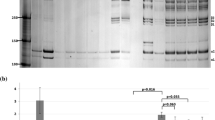Abstract
Vocal fold (VF) fibroblasts are the central subject of interest in fibrogenesis and wound healing after VF injury. Scar fibroblasts (SF) exhibit an aberrant production of several extracellular matrix (ECM) components which lead either to VF fibrosis or scarless wound healing. This study aimed to investigate the role of age at the time of injury on ECM production of SF. This is designed as an animal study. VF injury was established unilaterally in eight male Sprague-Dawley rats [3 months of age (n = 4), 11 months of age (n = 4)], while the other side was left intact. Three months after injury the larynges were excised and fibroblasts were extracted from VF [normal fibroblasts (NF)–scar fibroblasts (SF)] and cultured in vitro. After first passage, VF fibroblasts were plated in 24-well plates and levels of hyaluronic acid (HA) and collagen type I were determined enzymatically from supernatant after 24 and 72 h. Cultured SF from younger animals produced significantly higher levels of HA compared to NF fibroblasts from the same animals. HA concentrations of the older animals did not differ significantly between the NF and SF cultures, but the range in SF cultures was large. In contrast to previous studies, we found that even 3 months after VF injury cultured SF from young animals expressed higher levels of HA in comparison to SF from older animals. No difference in collagen levels were observed between the younger and older animals. Age of animals is an essential factor during VF healing and has to be considered for study design.




Similar content being viewed by others
References
Ling C, Yamashita M, Waselchuk EA, Raasch JL, Bless DM, Welham NV (2010) Alteration in cellular morphology, density and distribution in rat vocal fold mucosa following injury. Wound Repair Regen 18:89–97
Allen J (2010) Cause of vocal fold scar. Curr Opin Otolaryngol Head Neck Surg 18:475–480
Kumai Y, Kobler JB, Park H, Galindo M, Herrera VL, Zeitels SM (2010) Modulation of vocal fold scar fibroblasts by adipose-derived stem/stromal cells. Laryngoscope 120:330–337
Farran AJ, Teller SS, Jha AK et al (2010) Effects of matrix composition, microstructure, and viscoelasticity on the behaviors of vocal fold fibroblasts cultured in three-dimensional hydrogel networks. Tissue Eng Part A 16:1247–1261
Thibeault SL, Rousseau B, Welham NV, Hirano S, Bless DM (2004) Hyaluronan levels in acute vocal fold scar. Laryngoscope 114:760–764
Welham NV, Montequin DW, Tateya I, Tateya T, Choi SH, Bless DM (2009) A rat excised larynx model of vocal fold scar. J Speech Lang Hear Res 52:1008–1020
Tateya I, Tateya T, Lim X, Sohn JH, Bless DM (2006) Cell production in injured vocal folds: a rat study. Ann Otol Rhinol Laryngol 115:135–143
Kapetanaki MG, Mora AL, Rojas M (2013) Influence of age on wound healing and fibrosis. J Pathol 229:310–322
Tateya T, Tateya I, Sohn JH, Bless DM (2005) Histologic characterization of rat vocal fold scarring. Ann Otol Rhinol Laryngol 114:183–191
Lareu RR, Arsianti I, Subramhanya HK, Yanxian P, Raghunath M (2007) In vitro enhancement of collagen matrix formation and crosslinking for applications in tissue engineering: a preliminary study. Tissue Eng 13:385–391
Ohno T, Yoo MJ, Swanson ER, Hirano S, Ossoff RH, Rousseau B (2009) Regeneration of aged rat vocal folds using hepatocyte growth factor therapy. Laryngoscope 119:1424–1430
Gugatschka M, Kojima T, Ohno S, Kanemaru S, Hirano S (2011) Recruitment patterns of side population cells during wound healing in rat vocal folds. Laryngoscope 121:1662–1667
Hirano S (2005) Current treatment of vocal fold scarring. Curr Opin Otolaryngol Head Neck Surg 13:143–147
Ding H, Gray SD (2001) Senescent expression of genes coding tropoelastin, elastase, lysyl oxidase, and tissue inhibitors of metalloproteinases in rat vocal folds: comparison with skin and lungs. J Speech Lang Hear Res 44:317–326
Kumai Y, Kobler JB, Park H et al (2009) Crosstalk between adipose-derived stem/stromal cells and vocal fold fibroblasts in vitro. Laryngoscope 119:799–805
Yamashita M, Bless DM, Welham NV (2010) Morphological and extracellular matrix changes following vocal fold injury in mice. Cells Tissues Organs 192:262–271
Rousseau B, Hirano S, Scheidt TD et al (2003) Characterization of vocal fold scarring in a canine model. Laryngoscope 113:620–627
Thibeault SL, Gray SD, Bless DM, Chan RW, Ford CN (2002) Histologic and rheologic characterization of vocal fold scarring. J Voice 16:96–104
Chen CZ, Raghunath M (2009) Focus on collagen: in vitro systems to study fibrogenesis and antifibrosis state of the art. Fibrogenesis Tissue Repair 2:7. doi:10.1186/1755-1536-2-7
Xu Q, Norman JT, Shrivastav S, Lucio-Cazana J, Kopp JB (2007) In vitro models of TGF-beta-induced fibrosis suitable for high-throughput screening of antifibrotic agents. Am J Physiol Renal Physiol 293:F631–F640
Lareu RR, Subramhanya KH, Peng Y et al (2007) Collagen matrix deposition is dramatically enhanced in vitro when crowded with charged macromolecules: the biological relevance of the excluded volume effect. FEBS Lett 581:2709–2714
Chen CZ, Peng YX, Wang ZB et al (2009) The Scar-in-a-Jar: studying potential antifibrotic compounds from the epigenetic to extracellular level in a single well. Br J Pharmacol 158:1196–1209
Acknowledgments
The authors would like to thank Richard Ackbar, PhD for discussing and proofreading. This project was supported by the Styrian government.
Conflict of interest
None.
Author information
Authors and Affiliations
Corresponding author
Rights and permissions
About this article
Cite this article
Gugatschka, M., Ainödhofer, H., Gruber, HJ. et al. Age effects on extracellular matrix production of vocal fold scar fibroblasts in rats. Eur Arch Otorhinolaryngol 271, 1107–1112 (2014). https://doi.org/10.1007/s00405-013-2722-7
Received:
Accepted:
Published:
Issue Date:
DOI: https://doi.org/10.1007/s00405-013-2722-7




